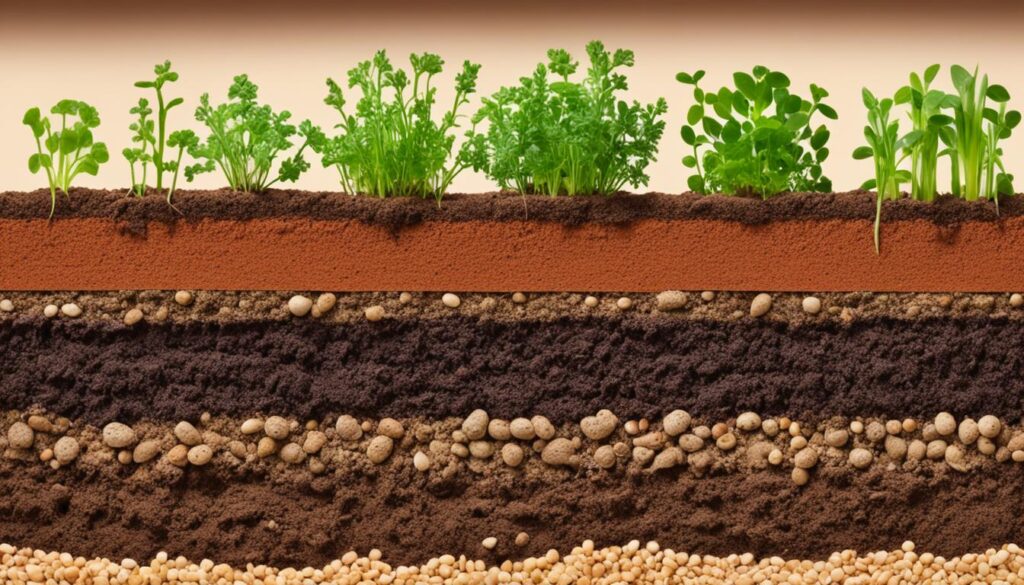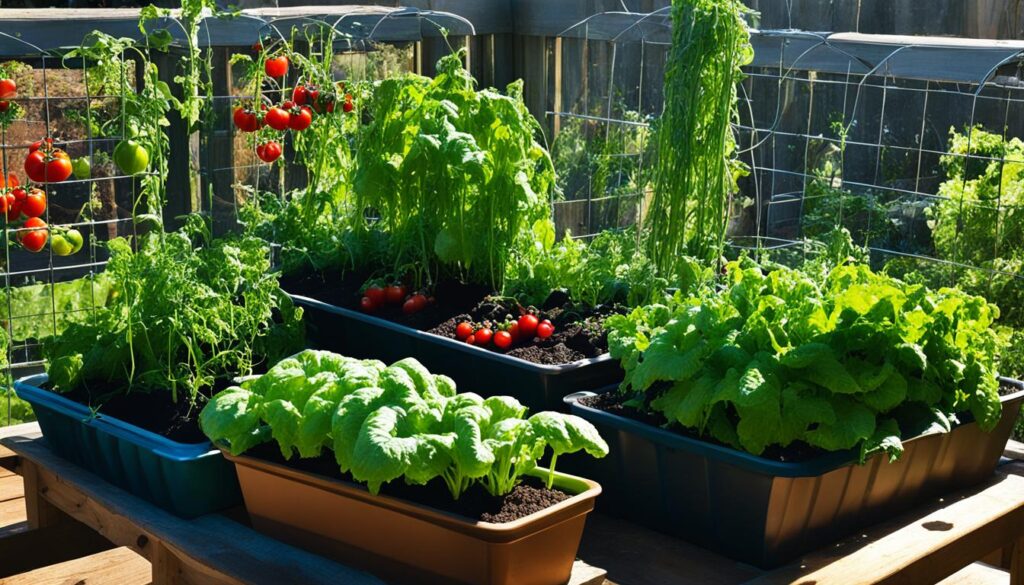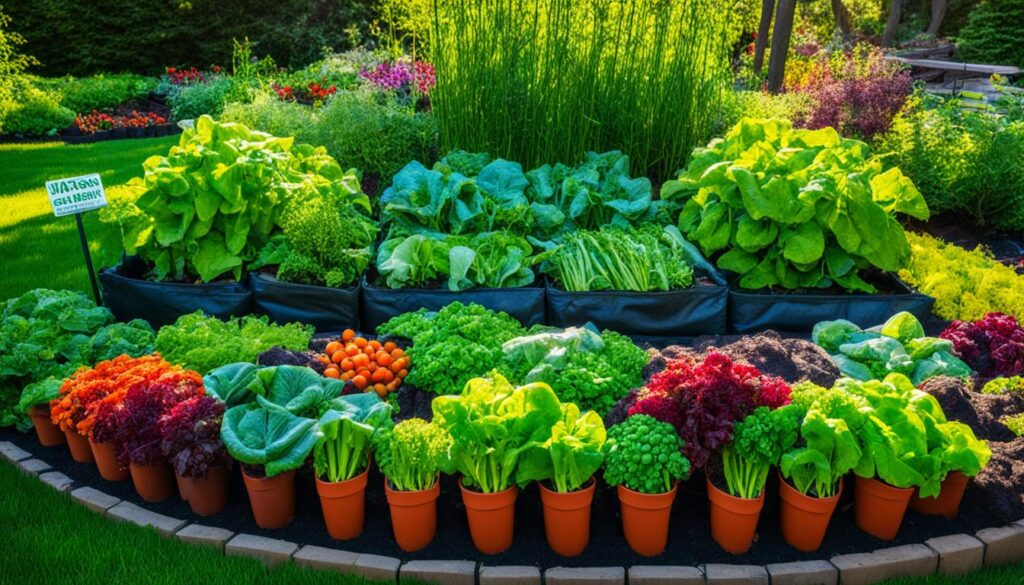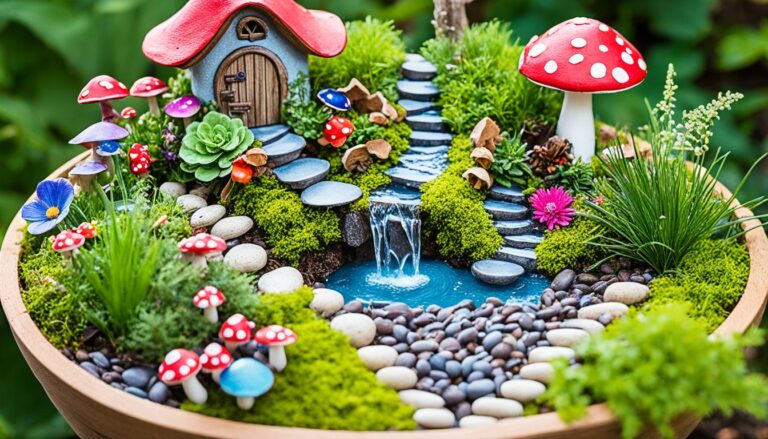Starting a home garden makes life more exciting. Picking the easiest vegetables to grow is key for success. Beginners can start with beginner-friendly vegetables. These veggies make gardening hassle-free and rewarding. Bell peppers add beauty with colors from green to chocolate. Caneberries like blackberries and raspberries are easy to care for. They just need simple pruning. Cabbages love cooler weather and bring a good harvest in autumn. Cucumbers and summer squash, such as zucchini, are also easy to grow. You can plant them in the ground or in pots.
In fall, garlic lovers will enjoy a great harvest. Strawberries spread on their own with “runners.” Tomatoes are a must-have, ranging from big to small. They need some support to grow well. Give them the right care with plant food and pest control. Use Sevin Insecticides, Corry’s Slug & Snail Killer, and Pennington UltraGreen All Purpose Plant Food 10-10-10 for the best results.
Key Takeaways
- Easiest vegetables to grow Start your garden with beginner-friendly vegetables for a rewarding and straightforward experience.
- Choose a variety of vegetables such as bell peppers, blackberries, raspberries, and cabbages for nutritional diversity.
- Embrace the versatility of cucurbit plants like cucumbers and zucchini for both in-ground and container gardening.
- Plan for a seasonal harvest with fall-planted garlic and self-propagating strawberries.
- Nurture tomato plants, from large beefsteak varieties to tiny cherries, with cages for optimal growth.
- Utilize recommended products such as Sevin Insecticides and Pennington plant food to protect and boost your plants.
Benefits of Growing Your Own Vegetables
For gardening fans, growing your own vegetables is more than fun. It brings fresh, healthy food right from your garden to your table. Plus, it’s a great feeling to see your hard work turn into a delicious meal.
Enhanced Nutrition and Freshness
Vegetables you grow yourself are much more nutritious and fresher than those you buy in the store. This is because they don’t lose their nutrients during a long journey. Plus, with the rising prices of items like a pint of fresh strawberries, growing your own makes sense both economically and for your health.
Gardening as a Relaxing Hobby
Gardening isn’t just about saving money; it’s a great way to relax. It can reduce stress and improve your overall mood. It’s a simple activity that can make a big difference in how you feel every day.
Cost-Effective and Sustainable Living
By growing your own vegetables, you help the planet. You cut down on pollution by not buying produce that’s been shipped far. Additionally, you save money on groceries. This way, you only take what you need, when you need it. It also teaches kids and the family valuable lessons. This makes for a smarter, more resourceful life.
| Produce | Cost Increase Since Last Year | Home Gardening Saving |
|---|---|---|
| Strawberries | 25% | Multiple grocery trips worth |
| Field-grown Tomatoes | 16.9% | Pesticide-free, fresh supply |
Growing your own food helps your wallet and your peace of mind. You know exactly where your food comes from. Discover more about the benefits of home gardening
Easiest Vegetables to Grow Getting Started with the Right Soil
Starting a great vegetable garden begins with the soil. Good soil is key for a healthy and productive garden. The right soil makes your plants grow strong, leading to a big harvest.
Deciphering Soil Fertility and Texture
For a great garden, you need to know what your plants like. This starts with the soil fertility and optimal soil texture. You want soil that’s full of nutrients, drains well, and has plenty of organic matter. This kind of soil improves plant growth. You can boost your soil by adding organic soil amendments like compost, manure, and rock dust. These additions make the soil richer in nutrients and better at holding water. They also help roots grow strong and deep.
Importance of Organic Matter for Your Garden
Using organic materials in your garden is a smart move. They add nutrients to the soil, making it better for plants. Compost and manure are great for this. They create a good space for plants to thrive. Covering your soil with mulch is also helpful. It keeps in moisture and keeps the soil the right temperature, while also helping keep the soil slightly acidic.
Getting the right balance with soil health is vital, not just for now but for future growth too. If you’re new to gardening or trying to improve, focusing on your soil is key. It sets the groundwork for successful gardening.
Easy-to-Grow Leafy Greens for Beginners
Starting a garden is exciting and rewarding. It’s especially great with easy leafy greens. These veggies add flavor to meals and beauty to your yard.
Various Types and Their Benefits
Beginners often choose lettuce, kale, and spinach. Each has its own taste and is good for different meals. There are many lettuce types, from crunchy romaine to soft Boston.
Spinach grows fast, while kale is tough and works in many recipes.
Best Practices for Cultivating Lettuce and Spinach
New gardeners should know the best ways to grow leafy greens. Lettuce likes cooler weather but can be grown year-round with some shade. This stops it from getting bitter.
Using perpetual harvest techniques helps keep fresh greens coming. For spinach, plant in fertile, well-drained soil. Adding compost before planting keeps the soil moist and full of nutrients.
Another tip is to space plants well. You can plant spinach among taller crops to keep it cool in summer. This keeps the spinach leaves fresh. Don’t forget to water and thin out seedlings for healthy growth.
Choose these easy crops to begin gardening. It’s not only fun but also leads to growing your own food. This is a big step toward a healthy, sustainable life.
Easiest Root Vegetables to Cultivate
Root vegetables are perfect for gardening, especially if you’re starting. Radishes, turnips, and carrots are key. They’re easy to grow and maintain. With a little care, anyone can succeed with radishes, grow tender carrots, and plant turnips like a pro.
Why Radishes, Turnips, and Carrots Are Great Choices
Radishes grow fast, ready in a few weeks, giving you a quick win. Turnips are hearty, giving you both roots and greens. Carrots need special care in the soil but offer a variety of flavors. This is especially true in cooler weather. They can taste like wood or be really sweet.
Tips for Soil Preparation and Maintenance
Prepare the soil well for these root veggies. Make sure it’s loose and has enough phosphorus or potassium, which is key for radishes and carrots. Leave enough room for the plants to grow, so they’re not crowded. For radishes and turnips, sow the seeds directly into good soil for the best results.
Here’s how to take care of these crops in the cold:
| Vegetable | Optimal Planting Time | Soil Preparation | Winter Care |
|---|---|---|---|
| Carrots | September – October | Loose, sandy soil with good drainage | Cover with straw mulch for protection |
| Radishes | September – Early October | Loose, rich in potassium or phosphorus | Minimal care needed |
| Turnips | September – October | Well-aerated, fertilized soil | Harvest before heavy frost for best flavor |
To learn more about growing root vegetables, check out Roots and Refuge. They have great advice for beginners.
Easiest Vegetables to Grow
Starting a garden can be daunting for newbies. But, picking the easiest vegetables to grow makes it fun and rewarding. These beginner-friendly vegetables need very little attention to do well. They’re a great way to dip your toes into gardening.
Lettuce is a top pick for quick-growing vegetables. It grows fast and is simple to look after. Green beans also score high for ease. You can plant them straight in the garden with almost no prep.
Cucumbers and zucchini are also easy. Just give them a basic trellis for their vines. This support keeps them off the ground and healthy. These vegetables are simple vegetables to cultivate.
| Vegetable | Key Growing Condition | Maintenance Level |
|---|---|---|
| Lettuce | Moist, well-drained soil | Low |
| Green Beans | Direct sunlight, moderate watering | Low |
| Zucchini | Trellising for support | Medium |
| Cucumbers | Trellis for climbing | Low |
| Carrots | Loose, sandy soil | Low |
| Amaranth | Heat tolerant | Low |
| Cucamelons | Continual fruit until frost | Low |
| Sungold Cherry Tomatoes | Routine watering and sunlight | Low |
| Microgreens | Indoor, sunny windowsill | Low |
Cucamelons and Sungold cherry tomatoes add unique tastes and keep giving. Microgreens grow quickly indoors. Placing them on a sunny windowsill means fresh greens in two weeks. These factors make them among the simplest vegetables to cultivate, ideal for new gardeners.
Starting with these hassle-free vegetables sets beginners up for early wins. Whether it’s robust green beans or sprawling cucamelons, each vegetable is a first step into the lovely world of gardening.
Easiest Vegetables to Grow Choosing the Right Container or Garden Bed
Delving into vegetable gardening means you must choose between traditional garden beds and modern containers. Your choice greatly affects how well your garden does. Think about your space, what you have, and what your plants need to thrive.
Different Planting Methods for Versatility
Choosing the right container or garden bed style is key for your veggies. If you live in a city or have little space, containers are a great option. They save space and look nice. Try options like Gardena NatureUp for small areas, perfect for strawberries and lettuce.
On the other hand, traditional garden beds give more room for a variety of crops. Raised beds and vertical gardens are creative choices that can make your garden look beautiful. They’re perfect for growing lots of different vegetables together.
Ensuring Proper Drainage for Optimal Growth
Good drainage is a must for containers in gardens. It stops the soil from getting too wet, which can harm your plants. Make sure your containers have enough holes to let water out. For a 5-gallon pot, aim for 6 to 8 holes.
Use a potting mix that drains well, made with 50% compost. It keeps your plants healthy. This type of mix stops the soil from getting hard and allows enough water to reach the plants.
Containers need extra care, like watering often and adding nutrients. This keeps the soil healthy because there’s not much of it. Plants like chilies and ‘Just Add Cream’ strawberries do really well if you take good care of them in containers.
| Vegetable | Ideal Container Size | Optimal Sunlight (Hours) | Special Care Instructions |
|---|---|---|---|
| Chili Peppers | 5-gallon | 6-8 | Weekly fertilizing during growing season |
| Strawberry ‘Just Add Cream’ | 2-gallon | 6-7 | Use acidic potting soil mix |
| Dwarf Carrot ‘Paris Market’ | 3-gallon shallow | 6-8 | Soil rich in compost for sweet, tender roots |
| Leaf Lettuce | 1-gallon | 3-5 | Keep soil consistently moist |
Easiest Vegetables to Grow Nurturing Your Plants with the Proper Nutrition
To get strong growth and lots of crops, you need to feed your plants well. It’s key to use the right plant nutrition and know how to do it. Adding organic fertilizers to your garden makes it more productive and earth-friendly.
Understanding Plant Food and Organic Fertilizers
Good plant growth depends on using organic fertilizers like compost and manure. These choices improve the soil and keep nature in balance. Adding high-quality compost helps give plants the nutrients they need over time.
Manure-based fertilizers are strong and great for veggies. They give plants nitrogen, phosphorus, and potassium. Using these helps keep your garden healthy without using bad chemicals.
Timing Your Fertilizer Applications for Best Results
Knowing when to feed your plants is crucial. Start feeding them two weeks before you plant. This gives the soil time to soak up the nutrients. Feeding again during the peak season keeps plants healthy.
It’s also important to change your feeding plan based on the season. Crops that grow in cooler weather need different care than those in hot weather. This approach makes sure every plant gets what it needs when it needs it.
Following these tips like adding compost and the right fertilizers helps your garden thrive. Providing proper plant food creates a garden that’s both rich and eco-friendly. Your garden will be healthier and more fruitful with each step you take in the right direction.
Maximizing Sun Exposure for Your Vegetable Garden
Getting enough sunlight is key for any vegetable garden to thrive. The right sunlight can boost plant growth and the harvest’s quality. Knowing how to use available sunlight helps sun-loving plants do well. It also lets you grow plants that prefer shade in hot areas.
Identifying Ideal Conditions for Sun-Loving Vegetables
For sun-loving plants, the right amount of sun is vital. Sunlight is crucial for photosynthesis, making plants stronger and healthier. Most vegetables need 6-8 hours of direct sun daily to grow their best. Cucumbers and tomatoes love full sun. Yet, peppers, strawberries, melons, and squash need at least 6 hours to grow their fruits well. For these vegetables, pick a spot that faces south or west. It should not be shaded by trees or buildings much.
Strategies for Shade-Growing Vegetables in Hot Climates
In hot areas, a balance of sun and shade is key. Shade cloths can protect plants from too much sun. They keep the area cooler. Use them when it’s over 85ºF. This helps keep plants from getting too stressed to fruit well.
Using mirrors or foil to reflect sunlight is another good idea. It can bring more light to plant-dense areas. Keep track of the sun’s path to position plants where they get light all day. Taller plants should go on the north side. This way, they won’t block sunlight from shorter ones.
| Vegetable | Minimum Sun Exposure | Ideal for Shade |
|---|---|---|
| Salad Greens | 3-4 hours | Yes |
| Root Vegetables (Carrots, Beets) | 5-6 hours | Yes |
| Tomatoes, Peppers | 7-8 hours | No |
| Squash, Cucumbers | 6+ hours | No |
| Fruiting Plants (Strawberries, Melons) | 7-8 hours | No |
By using these tips, every plant in your garden can get the right amount of sunlight. This helps them grow without being stressed by too much heat. It makes your garden more productive and healthy.
Conclusion
Easiest vegetables to grow The adventure of easy vegetable gardening is open to anyone, not just the plant wizards. You’ll discover the joy of beginner garden tips and the beauty of nature. The National Gardening Association points out that home gardening can be very rewarding. You might start with a small investment, like buying organic heirloom tomato seeds. These seeds could grow into lots of tomatoes, saving you money on store-bought ones.
Whether you have a small space or a big sunny yard, growing your own food is smart and fun. Imagine getting 30 pounds of tomatoes from just one plant. By learning some successful home harvest techniques, you can produce a lot without wasting. Just focus on the veggies you truly enjoy. This way, every bite of your homegrown produce will be special.
The story of vegetable cultivation conclusions is all about being green, staying healthy, and finding joy. Planting and caring for your garden goes hand in hand with nature’s rhythm and your own surroundings. It leads to a dinner table full of fresh lettuces, crunchy cucumbers, sweet carrots, colorful peppers, and more. Cooking with your own crops feeds your body and soul, showing growth in gardens and within us.

















